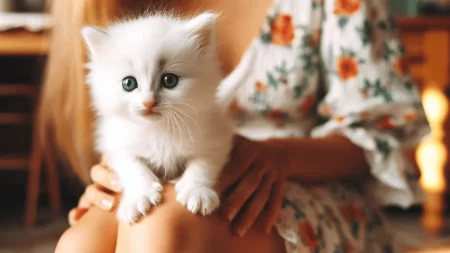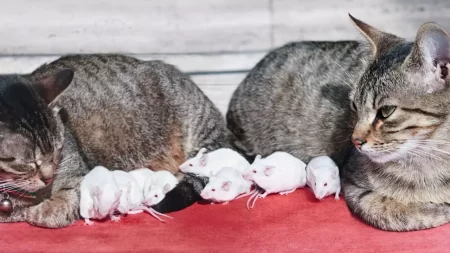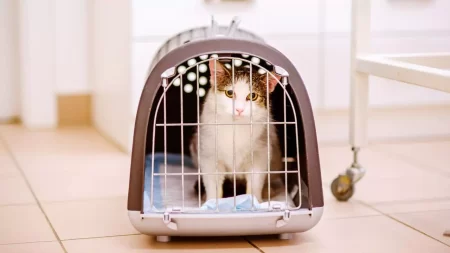Cats possess the ability to hold their breath at will, as evidenced by anecdotes shared on Reddit. According to a user’s observation, their cat demonstrated this skill by holding its breath for a notable duration, specifically ranging from 20 to 30 seconds. This intriguing behavior adds to the feline repertoire of unique traits, showcasing their adaptability in various situations.
Physiology of Cat Breathing
Respiratory System
The cat’s respiratory system includes the nose, mouth, pharynx, larynx, trachea, bronchi, bronchioles, and alveoli. Air enters and leaves the respiratory system through the nose and mouth. The pharynx joins the nose, mouth, and larynx. The larynx houses the vocal cords and epiglottis. When cats swallow, the epiglottis closes across the larynx to keep food and water out. Air travels from the larynx to the bronchi via the trachea. The two main trachea branches, the bronchi, split into bronchioles. Gas exchange happens in the alveoli at the end of bronchioles. Capillaries, small blood veins that carry oxygen and carbon dioxide between the lungs and body, surround the alveoli.
Breathing Patterns
Cats’ breathing patterns depend on their activity, temperature, health, and mood. Cats have a normal resting respiratory rate of 20–30 breaths per minute and a heart rate of 140–220 beats per minute. Exercise, tension, excitement, and heat can increase a cat’s respiratory rate to 60 breaths per minute. A cat’s heart rate can rise to 300 bpm in these scenarios. A cat’s respiratory rate might drop to 10 breaths per minute during sleep, relaxation, or cold. A cat’s heart rate can drop to 120 beats per minute under these conditions.
Underwater Breathing
Cats and Water
In general, cats don’t like water and will try to stay dry if they can. Cats have thick fur that keeps them warm and cool by trapping air. But when cats get wet, their fur loses its air and warmth, making it heavy and uncomfortable. This makes cats sad, cold, and open to being hurt. Cats like to stay dry and clean themselves with their mouths, which have tiny barbs that help get rid of parasites and dirt.
But not all cats don’t mind water. Turkey Van, Maine Coon, and Bengal cats are known to like swimming and being near water. The cats can do this because their fur doesn’t easily get wet, and their bodies are strong and powerful, which helps them swim well. Cats that live near water and hunt fish and other aquatic prey may have gotten these features from their ancestors.
Bathing Behavior
Cats do not need to be bathed regularly, as they are very clean animals that groom themselves frequently. However, sometimes cats may need to be bathed for medical or hygiene reasons, such as when they have fleas, ticks, mites, infections, allergies, or skin problems, or when they get dirty, oily, or smelly. In these cases, it is important to bathe cats gently and carefully, using warm water, mild shampoo, and a soft towel. It is also important to avoid getting water in the cat’s ears, eyes, nose, or mouth, as this can cause irritation, infection, or choking.
Underwater Reaction
Cats can breathe underwater, but they do not like to do so. When cats are submerged underwater, they will instinctively close their glottis and hold their breath, as they do when they voluntarily hold their breath. However, this is not a pleasant experience for cats, as they will feel panic, stress, and discomfort. Cats will try to escape from the water as soon as possible and will resume breathing once they reach the surface. If cats are forced to stay underwater for too long, they will reach their breakpoint and start to breathe involuntarily, which can cause water to enter their lungs and cause drowning.
Medical Conditions Affecting Breath Holding
Respiratory Illness
Cats often have respiratory illnesses. Respiratory sickness can be caused by viruses, germs, fungi, parasites, allergies, traumas, or malignancies. Respiratory sickness can affect the nose, throat, larynx, trachea, bronchi, bronchioles, and alveoli. Respiratory infection can include sneezing, coughing, wheezing, snoring, nasal discharge, difficulty breathing, and fast breathing. Due to reduced oxygen intake, increased carbon dioxide output, and impaired lung gas exchange, respiratory disease can also impair cats’ breath-holding abilities. Thus, cats with respiratory illnesses may need to breathe more often and deeply.
Anxiety and Stress
Stress and anxiety harm cats’ mental and physical health. Changes in the surroundings, isolation from the owner, unexpected persons or animals, loud noises, or traumatic occurrences can trigger anxiety and tension. Anxiety and stress can induce the fight-or-flight reaction, which affects cats’ respiration. Cats’ heart rate, blood pressure, breathing rate, and adrenaline and cortisol levels rise during the fight-or-flight reaction. Anxiety and stress can increase oxygen demand, reduce carbon dioxide removal, and disrupt pulmonary gas exchange, affecting cats’ breath-holding abilities. Thus, cats with worry and tension may need to breathe more often and shallowly.







